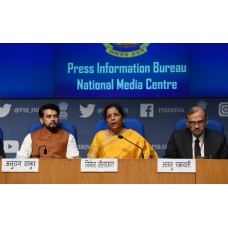Budget harnessed new technologies!
Data is the new oil
FM clarified her vision & an essence of the proposed budget 1920-21. She said this budget is not Industry or Sector specific! All those necessary & needed areas are being addressed and that would vibrant economy to run every industry & commerce better to reach our short term target of US$5tn economy size.
New Economy:
The new economy is based on innovations that disrupt established business models. Artificial intelligence, Internet‐of‐Things (IoT), 3D printing, drones, DNA data storage, quantum computing, etc., are re‐writing the world economic order. India has already embraced new paradigms such as the sharing economy with aggregator platforms displacing conventional businesses.
Government has harnessed new technologies to enable direct benefit transfers and financial inclusion on a scale never imagined before. It is now a cliché – “data is the new oil” and it is true that Analytics, Fintech and Internet of Things (IOT) are changing the way we deal with our lives.
To take advantage of this, FM proposes, 1: To bring out soon a policy to enable private sector to build Data
Centre parks throughout the country. It will enable our firms to skilfully incorporate data in every step of their value chains. 2: Our vision is that all “public institutions” at Gram Panchayat level such as Anganwadis, health and wellness centres, government schools, PDS outlets, post offices and police stations will be provided with digital connectivity.
So, Fibre to the Home (FTTH) connections through Bharatnet will link 100,000 gram panchayats this year.
It is proposed to provide ` 6000 crore to Bharatnet programme in 2020‐21. It is proposed to provide an outlay of Rs8000 croreover a period five years for the National Mission on Quantum Technologies and Applications.
Industry, Commerce and Investment:
Entrepreneurship has always been the strength of India. Even today, young men and women have given up greener pastures elsewhere to contribute to India’s growth. They are risk‐taking and come up with disruptive solutions to festering challenges. Equally, established old industries are resetting themselves in a changing global and domestic situation.
We recognise the knowledge, skills and risk‐taking capabilities of our youth. He is no longer the job seeker. He is creator of jobs. Now we wish to create more opportunities and remove road‐blocks from his path. I propose to set up an Investment Clearance Cell that will provide “end to end” facilitation and support, including pre‐investment advisory, information related to land banks and facilitate clearances at Centre and State level. It will work through a portal.
There is a case for maximising the benefits of three separately developing economic activities: (1) the upcoming economic corridors; (2) revitalisation of manufacturing activities; and (3) Technology and the demands of aspirational classes. We have to benefit from their convergence. Hence, it is proposed to develop five new smart cities in collaboration with States in PPP mode. Such sites would be chosen that offer the best choices in terms of aforementioned principles.
Government e‐Marketplace (GeM) is moving ahead for creating a Unified Procurement System in the country for providing a single platform for procurement of goods, services and works. It offers a great opportunity for Medium, Small and micro Enterprises (MSMEs). 3.24 lakh vendors are already on this platform. Its proposed to take its turnover to Rs3lakh crores.
I propose to provide about Rs27,300 crore for development and promotion of Industry and Commerce for the year 2020‐21. Under the theme “Economic Development”, the second focus is on Infrastructure.
Education and Skills:
The third and the final item under Aspirational India is Education and Skills. By 2030, India is set to have the largest working‐age population in the world. Not only do they need literacy but they need both job and life skills. Dialogues have been held with State Education Ministries, Members of Parliament and other stake‐holders about Education policy.
Over 2 lakh suggestions were also received. The New Education Policy will be announced soon. It is felt that our education system needs greater inflow of finance to attract talented teachers, innovate and build better labs. Therefore steps would be taken to enable sourcing External Commercial Borrowings and FDI so as to able to deliver higher quality education.
Students in the general stream (vis‐à‐vis services or technology stream) need their employability improved. About 150 higher educational institutions will start apprenticeship embedded degree/diploma courses by
March 2021. The government proposes to start a programme whereby urban local bodies across the country would provide internship opportunities to fresh engineers for a period up to one year.
In order to provide quality education to students of deprived section of the society as well as those who do not have access to higher education, it is proposed to start degree level full‐fledged online education programme. This shall be offered only by institutions who are ranked within top 100 in the National Institutional Ranking framework. Initially, only a few such institutions would be asked to offer such programmes.
India should be a preferred destination for higher education. Hence, under its “Study in India” programme, Ind‐SAT is proposed to be held in Asian and African countries. It shall be used for benchmarking foreign candidates who receive scholarships for studying in Indian higher education centres. Government proposes to provide about ` 99,300 crore for education sector in 2020‐21 and about Rs3,000 crores for skill development.




